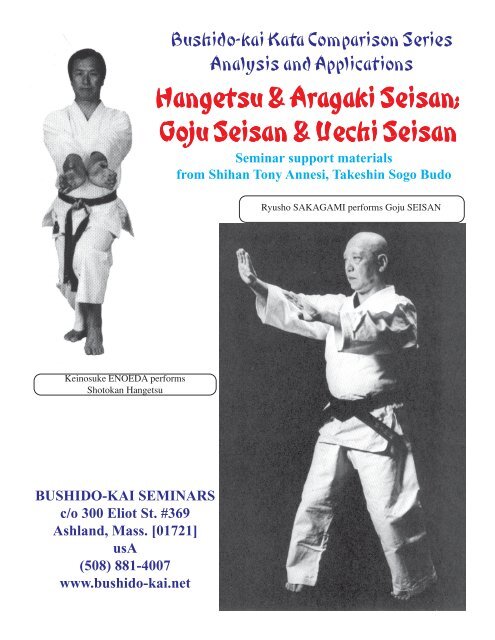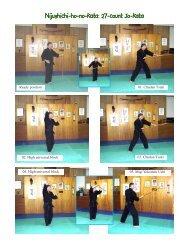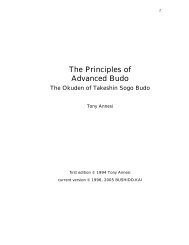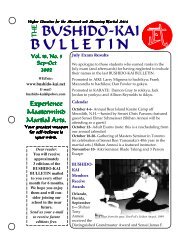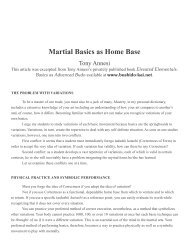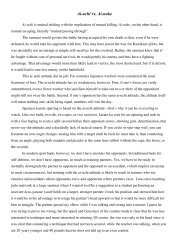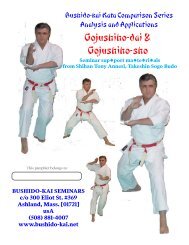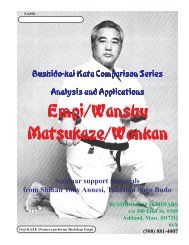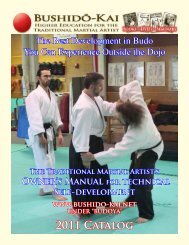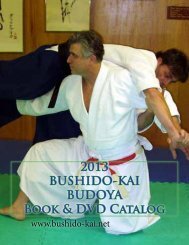Hangetsu & Seisan - Bushido-Kai
Hangetsu & Seisan - Bushido-Kai
Hangetsu & Seisan - Bushido-Kai
You also want an ePaper? Increase the reach of your titles
YUMPU automatically turns print PDFs into web optimized ePapers that Google loves.
<strong>Bushido</strong>-kai Kata Comparison Series<br />
Analysis and Applications<br />
<strong>Hangetsu</strong> & Aragaki <strong>Seisan</strong>;<br />
Goju <strong>Seisan</strong> & Uechi <strong>Seisan</strong><br />
Seminar support materials<br />
from Shihan Tony Annesi, Takeshin Sogo Budo<br />
Ryusho SAKAGAMI performs Goju SEISAN<br />
Keinosuke ENOEDA performs<br />
Shotokan <strong>Hangetsu</strong><br />
BUSHIDO-KAI SEMINARS<br />
c/o 300 Eliot St. #369<br />
Ashland, Mass. [01721]<br />
usA<br />
(508) 881-4007<br />
www.bushido-kai.net
History & Name<br />
HANGETSU & SEISAN<br />
Information compiled by Shihan Tony Annesi<br />
• The stance that is used in <strong>Hangetsu</strong> kata is called hangetsu-dachi or half-moon stance. It is a long, wide sanchin stance,<br />
often, if erroneously, referred to as an hour-glass stance.<br />
• FUNAKOSHI Sensei changed the name from its original <strong>Seisan</strong> which means thirteen to <strong>Hangetsu</strong> which literally<br />
means “Half Moon.” The getsu or gatsu can also mean “month.”<br />
• Half a month is 15 days, not 13, however; so, either <strong>Hangetsu</strong> adds 2 techniques to the original 13 or there is another<br />
interpretation implied.<br />
• some argue that this kata came from an Okinawan folk dance related to moon phases.<br />
• Rob Redmond (Shotokan World website) suggests that the 13 techniques of the <strong>Hangetsu</strong> version of <strong>Seisan</strong> are as<br />
follows: 1. Inside block; 2. Punch; 3. Pull back; 4. Two-handed one knuckle strike; 5. inside ridge hand blocks; 6. knife<br />
hand blocks downward; 7. Wrist lock; 8. Overhead vertical back fist with wide, high stepping action; 9. Front snap kick;<br />
10. Downward block; 11. Upper rising block; 12. Crescent kick; 13. Palm heel block<br />
• the Goju (and perhaps the Uechi) version of <strong>Seisan</strong> are related to older forms in the following Chinese systems: Dragon<br />
Boxing, Arhat Boxing, Lion Boxing<br />
• another interpretation is that the embusen of the kata is like the kanji for ten (º) and three (£) overlayed on each other and<br />
viewed laterally.<br />
• still another interpretation of the “13” name is that it refers to a numbered kyusho points (or set of points) that the kata<br />
attacks (McCarthy suggests Posterior midline—cervical vertebrae—GV14.)<br />
• the “<strong>Hangetsu</strong>” version of <strong>Seisan</strong> is preserved in Shuri-te karate forms and is among the oldest kata in karate.<br />
• Juhatsu KYODA (student of both Kanyu and Kanryu HIGASHIONNA) supposedly had 2 versions of <strong>Seisan</strong> kata but<br />
did not perform Kanryo’s because it felt it was too similar to the one preserved by Goju. Perhaps the one he did preserve was<br />
similar to Aragaki’s ore, more likely, to Uechi’s?<br />
General<br />
• the first half of <strong>Hangetsu</strong> is similar to a Goju breathing & dynamic tension kata<br />
• the version of Aragaki <strong>Seisan</strong> we perform in this seminar is actually a recreation of Aragaki’s version of the kata from<br />
the research of Patrick McCarthy<br />
• the Goju version of <strong>Seisan</strong> is considered an intermediate to advanced kata; the Uechi version is solidly intermediate,<br />
being the middle of three traditional kata taken from the Chinese Pangai-noon system by Kanbum UECHI<br />
• the Aragaki and Shotokan versions have a distinct similarity while the Goju and Uechi versions have a distinct similarity—it<br />
has long been theorized that because the roots of Goju and the roots of Uechi both are in Fukien province, that their<br />
Chinese antecedents were related. Similarly, since Seisho ARAGAKI was a proto-Shorin stylist (Tomari-te) and since<br />
Funakoshi’s <strong>Hangetsu</strong> comes from Shorin kata, it would make since that Aragaki <strong>Seisan</strong> and Shotokan <strong>Hangetsu</strong> would<br />
look similar. The two root methods also have similarities.<br />
• Supposedly, Goju <strong>Seisan</strong> is a “hard” rather than a “soft” kata and concentrates on atemi (striking). However, our Takeshin<br />
interpretation has a number of locking and throwing movements.<br />
Other Versions<br />
• Generally, only Shotokan practices <strong>Hangetsu</strong>; but, a version of <strong>Seisan</strong> is practiced by the majority of other styles.<br />
References:<br />
• DOLLAR, Alan, Secrets of Uechi Karate and the Mysteries of Okinawa, Cherokee Publishing, 1996.<br />
• KANAZAWA, Hirokazu, Shotokan Karate International Kata (Vol. 1), 1981.<br />
• MATTSON, George E., The Way of Karate, Tuttle Publishing, 1963.<br />
• MATTSON, George E., Uechiryu Karate-do, Peabody Publishing, 1974.<br />
• McCARTHY, Patrick (trans.), Bubishi, The Bible of Karate, Tuttle , 1995.<br />
• MORRIS, Vince & Aiden TRIMBLE, Karate Kata and Applications (Vol 4 ) Stanley Paul Pub., 1991.<br />
• NAKAYAMA, Masatoshi, Best Karate (Vol. 11), Kodansha International, 1989.<br />
• PORTOCARRERO, Pierre, De la Chine à Okinawa: TODE, les originses du aKARATE-DO, SEDIREP (France), 1986.<br />
• REDMOND, Rob, Shotokan Planet Website (http://www.24fightingchickens.com).<br />
• SAKAGAMI, Ryusho, Karate-do Kata Taikan, Japan Publications, 1978.<br />
BUSHIDO-KAI SEMINARS, c/o 300 Eliot St., Ashland, Mass. [01721] 508 881-4007<br />
www.bushido-kai.net
Teiji KAZE performs Shotokan <strong>Hangetsu</strong>.<br />
Shotokan HANGETSU
Morio HIGAONNA performs Goju <strong>Seisan</strong>.<br />
Goju SEISAN
Kanei UECHI performs Uechi <strong>Seisan</strong>.<br />
Uechi SEISAN<br />
The kata line has been urned at 45º for clarity of viewing.
The Kata line has been turned back to its original orientation for clarity fo viewing.


